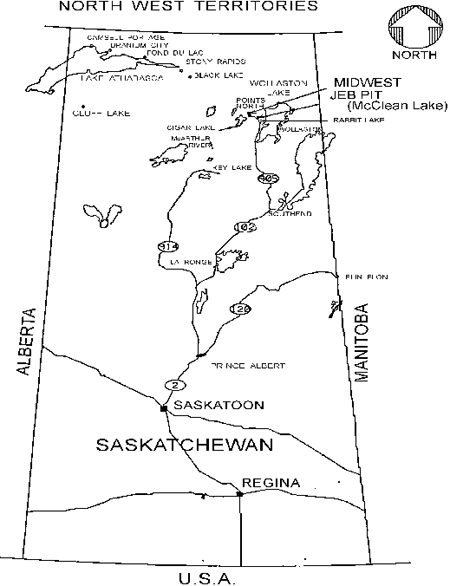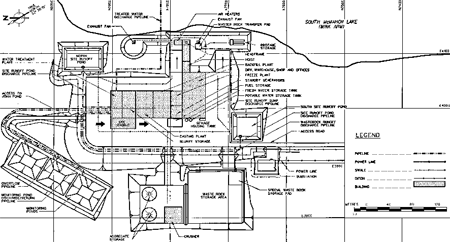Archived Content
Information identified as archived is provided for reference, research or recordkeeping purposes. It is not subject to the Government of Canada Web Standards and has not been altered or updated since it was archived. Please contact us to request a format other than those available.
Panel Report
2.0 Project Description and Site Map
2.1 Proposal
The Midwest uranium deposit is located about 60 km west of the nearest community, Wollaston Lake, and approximately 700 km north of Saskatoon. It is close to Points North and connected to Provincial Road 905 by a 2-km access road. See Figure 1.
The ore body was discovered in 1978 beneath the Mink Arm of South McMahon Lake. An Environmental Impact Statement was submitted in 1981 for a proposal that included open pit mining and on-site milling of the ore. Due to a corporate decision to defer development of the project, a formal review was not initiated in 1981.
Ownership changed in 1987, with the Midwest Joint Venture acquiring the property. After obtaining approvals to proceed with an exploration program assessing underground conditions and gathering data to evaluate potential mining methods, the Midwest Joint Venture constructed a test mine at the site in 1988.
Upon completion of test mining, the Midwest Joint Venture applied in 1991 for approval to construct and develop an underground mine, a mill and a tailings disposal area. This proposal was amended in 1992 to reflect a decision to develop the Midwest and McClean Lake ore bodies on a complementary basis.
The joint panel reviewed the 1992 Midwest proposal, and recommended that permission to proceed not be granted because "the benefits that could be obtained are insufficient to balance the perceived risks." [D.G. Lee, J.F. Archibald, J. Dantouze, R. Neal and A. Yassi, Dominique-Janine Extension, McClean Lake Project, and Midwest Joint Venture, Supply and Services Canada, October, 1993, p. 35.] The federal and provincial governments concurred with the panel's recommendation.
In 1994, Cogema Resources Inc., the new operator for the project, submitted a proposal to develop the Midwest Project using a different mining method that appeared to respond to many of the deficiencies that the panel had identified in its review of the 1992 Midwest Joint Venture proposal. Environmental assessment approval was sought from the federal and provincial governments.
The ore body which Cogema proposes to develop is approximately 200 m beneath the Mink Arm of South McMahon Lake, in a geologic formation where the Athabasca sandstone meets the underlying basement rock. The ore, expected to have an average grade of 3.8 per cent U308, is concentrated in an area 100 m wide by 250 m long and varying in thickness from 2 to 30 m. The proponent estimates that the mineral reserves will yield 13,200 tonnes of uranium.
Cogema proposes to freeze the deposit before mining, thus avoiding the need to drain Mink Arm and the accompanying environmental damage. Ore would be mined from a production gallery beneath the frozen deposit by a non-entry, jet-boring method that would minimize the exposure of miners to radioactive material. The resulting ore slurry would be hoisted hydraulically to the surface, and stored in air-agitated tanks. The cavities remaining underground after jet boring would be backfilled with special concrete.
In preparation for mining, access to the development area underneath the ore body would be through the existing test mine shaft, extended deeper by about 60 m. Parallel freeze galleries would be excavated in the basement rock approximately 20 m below the ore body. A brine solution, cooled to -35oC, would then be circulated through vertical holes drilled upward and extending through the ore body, freezing the entire area from the freeze galleries to about 5 m above the deposit. The production gallery would then be developed between, and about 10 m above, the freeze galleries.
From the production gallery, holes would be drilled completely through the frozen ore body. Casing would be installed and the head of a jet-boring machine, introduced through the holes, would cut the surrounding ore with high-pressure water jets. The slurry produced would be contained within shielded pipes and vessels at all times. After crushing and grinding, it would be hydraulically hoisted to the surface in a dedicated pipeline.
After thickening, the ore slurry would be pumped into transportation vessels and trucked to the McClean Lake mill for processing. The tailings resulting from the milling of the Midwest ore would be thickened to paste consistency, and then disposed of subaqueously in the JEB pit at the McClean Lake site.
Mine water inflows in the Midwest development are predicted to be approximately 50 m3/hour. Some of the inflow would be used in the drilling and jet-boring processes; the remainder would be pumped to the water treatment plant on surface, with effluent from the plant being released to Mink Arm.
Figure 1: Location of the Proposed Midwest Project as outlined in Section 1.1

Waste rock from mining would be either stockpiled on surface, or transported to the McClean Lake site for disposal in a mined-out pit, depending on the concentrations of uranium, arsenic, nickel and sulphur in the waste. As much as possible of the stockpiled, clean waste would be used as aggregate in the preparation of the concrete for backfilling the jet-bored cavities. Similarly, much of the special waste with its higher concentrations of uranium, arsenic, nickel and sulphur would be used as backfill for abandoned freeze and production galleries underground.
The surface facilities needed at the South McMahon Lake site to support the Midwest proposal would include a freeze plant; a concrete mix plant; a power substation; office, change room, maintenance shop and warehouse space; a water treatment plant; and ore storage and loading facilities. See Figure 2.
The Midwest Project would provide approximately 300 person-years of work during the 2-year development phase and employ about 122 workers for the 6-year operational phase. It is estimated that 77 of these workers would be transfers from the McClean Lake Project and that the remainder, 45, would be new hires. [The Midwest Project, Supplementary Information, Cogema Resources Inc., May, 1996, S.3, Attachment A, Table 1.]
2.2 Ownership
Cogema Resources Inc. is the proponent of the Midwest proposal on behalf of the four partners which have equity positions in the Midwest Joint Venture: Minatco Ltd., a subsidiary of Cogema Resources Inc. (56.0 per cent); Uranerz Exploration and Mining Ltd. (20.0 per cent); Tenwest Uranium Ltd., a subsidiary of Denison Mines Ltd. (19.5 per cent); and OURD (Canada) Ltd. (4.5 per cent).
2.3 Comparison of the 1992 and 1995 Midwest Proposals
When the panel recommended that the 1992 Midwest proposal not be approved, it identified several significant project-specific concerns. The new proposal addressed many of these concerns by describing different mining methods or new technologies. Table 1 summarizes how the mining, transport and tailings management approaches described in the new proposal differ from those of the previous proposal.
Figre 2: Midwest Mine Site - Surface Facilities Layout

| CONCERNS WITH 1992 PROPOSAL | DIFFERENT APPROACHES IN THE 1995 PROPOSAL |
|---|---|
| Use of unacceptable mining methods. | Use of a jet-boring technique, tested at the Cigar Lake test mine, should be a safer mining method. |
| Mining, in confined underground spaces, of an ore that contains high concentrations of uranium, arsenic and nickel. | Automated mining from locations in the basement rock, underneath the ore body, should reduce exposure of miners to radioactivity and toxic heavy metals. |
| The existence of over 600 exploration bore holes, most of them uncapped, in the vicinity of the ore body. | Freezing of the ore body would seal the bore holes during the operational phase. |
| The need to transport high grade ore on a public highway. | Ore, in slurry form, would be transported in specially designed and constructed vessels. |
| The potential for environmental damage through the release of contaminated effluent into the Smith Creek watershed and the need to dewater an area of several square kilometres around the mine site. | Dewatering of Mink Arm and the surrounding area would not be required and the volume of effluent released would be greatly reduced. |
| Uncertainties in the disposal of mill tailings containing high concentrations of toxic heavy metals. | Protection from dust would be enhanced by the subaqueous disposal of tailings; however, there are concerns remaining regarding contamination of ground water. |
| The contribution of this proposed mine to the combined effects of all of the mines (existing and proposed) in a relatively small area on the west side of Wollaston Lake. | The new mining methods and technologies proposed are intended to decrease loadings of contaminants to the environment. |
- Executive Summary
- 1.0 Introduction
- 2.0 Project Description and Site Map
- 3.0 Historical Experience of the Midwest Proponent
- 4.0 Recommendations and Conditions
- 5.0 Socio-Economic Benefits
- 6.0 Midwest Site
- 7.0 Worker Health and Safety
- 8.0 Transportation
- 9.0 Milling and Tailings Disposal
- 10.0 Modelling, Monitoring and Cumulative Effects
- 11.0 Community Health and Social Impacts
- 12.0 Decommissioning
- Appendix A - Panel Member Biographies
- Appendix B - Terms of Reference
- Appendix C - Panel Activities
- Appendix D - Submissions to Panel
- Appendix E - Bibliography of Review Documents
- Appendix F - Participant Funding Program
- Date Modified: